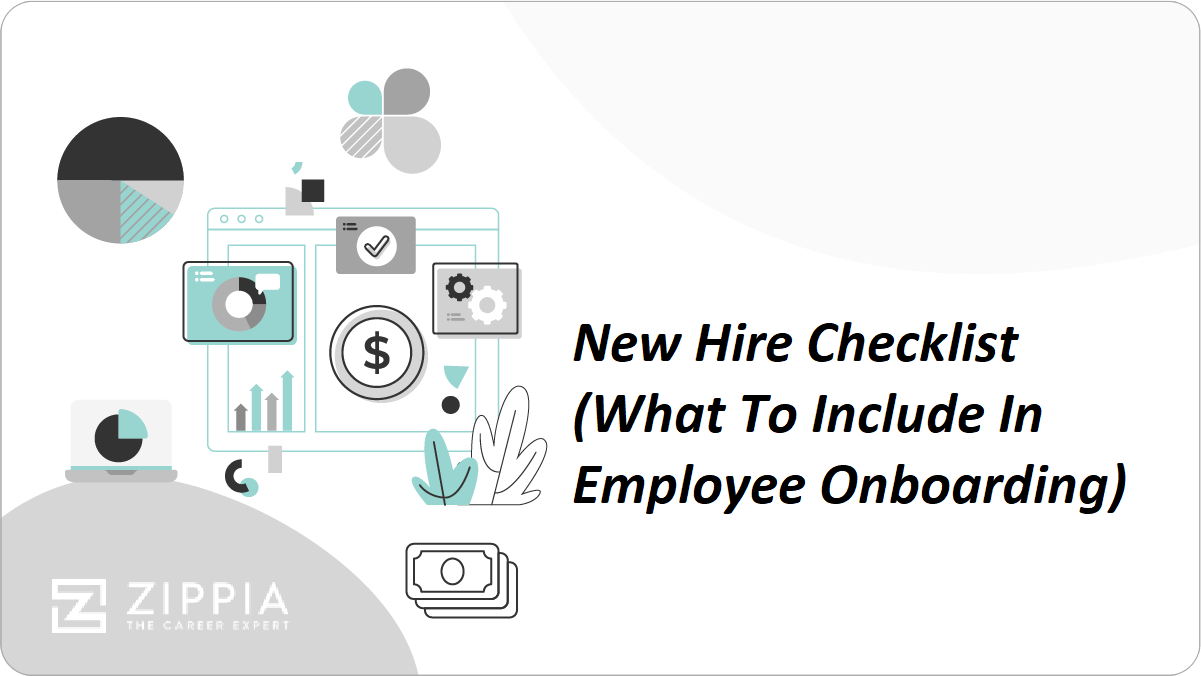By clicking Download, you agree to Zippia’s Privacy Policy and Terms of Use.

Summary. Creating a new hire onboarding checklist ensures you don’t miss any important steps as your new employees familiarize themselves with their new company. The onboarding process begins after you make a decision to hire someone, so your checklist should start as early as one month before they start. The checklist should also include what needs to be done one week before the first day, their first day, during the first week, and during the first month.
When new employees start their job, it’s important to have a comprehensive onboarding plan in place. Although many employers hope to have the time to train their employees on every single detail, there can be the potential for oversight. That’s why new hire onboarding checklists are so important.
An onboarding checklist is beneficial for both the employer and the employee. Oftentimes there are tasks that the employee can perform themselves, they can accomplish with different departments or ones they may need your help with. Having everything in one place makes it so that you ensure your new employee doesn’t miss a step.
Below are the different steps you may want to include in your new hire checklist after hiring a new employee.
Key Takeaways:
-
Successful onboarding for a new hire can lead to better job performance, increased employee satisfaction, and better retention rates.
-
One week before the new employee starts, you should gather the welcome materials, provide anything for HR, and announce the new hire.
-
On their first day you should outline expectations ang give them access to any programs that they will need to complete the job.

One Month Before Your Employee Starts
The onboarding process begins after you’ve made your decision to hire your new employee. You’ll want to make sure you make this process as seamless as possible, as it’s the first impression your new employee will get about your organization. One month before your employee begins work, consider the following:
-
Offer letter and employment contract. Be sure your employee receives their offer letter. Many organizations require signatures on these letters, so be sure you have all signatures and agreements in place to confirm their commitment to employment.
-
Start date. Assuming your new employee is currently employed elsewhere, you must have a conversation with them to agree on a start date. Once confirmed, send them the details of their start date, like what time to arrive, dress code details, and where to go.
-
Equipment and supplies. Sometimes orders can be backlogged, so ensure you place your orders for computers, desks, business cards, and uniforms in plenty of time before your new employee begins.
One Week Before Your Employee Starts
It’s best practice to give yourself about a week to fully prepare all of the details you must consider before a new employee begins at your company. Remember that it’s important to ensure your new employee feels welcomed to the team. This will ultimately improve their overall morale and performance. One week before your employee begins, consider:
-
Welcome materials. Send your employee a welcome email with the employee handbook attached. It’s a good idea to also reiterate their first-day details as well as any parking or public transport information, as well as a brief schedule for their first day, so they know what to expect.
-
HR employee records. Be sure HR has all of the information they need for the new employee to start, including their name, address, contact details, position, start date, salary, and anything else they may need.
-
New hire announcement. Be sure to prepare and send a new hire announcement message to the company or the relevant team members (depending on the size of your company.) Be sure to indicate their start date and encourage the team or company to be as welcoming as possible.
-
Logistics. Set up your new employee’s workspace, arrange their computer and other materials, and create a plan for their first week at work. Oftentimes this will include them spending time with different departments or leadership teams to get a better understanding of the company.
By clicking Download, you agree to Zippia’s Privacy Policy and Terms of Use.

Your employee’s first day
The first days can be stressful for both employee and employer. It’s a great idea to consider clearing your calendar as much as possible that first day so that you can give them your undivided attention. Here are some considerations to make on your checklist for your employee’s first day in the office.
-
Welcome them. Although it seems obvious, providing a welcoming environment for your employee is extremely important. Be sure to show them their working area, their equipment, and any policies relevant to entering and exiting the building, and give them an orientation tour of the office, such as where the restrooms or coffee machines are.
-
Outline expectations. The first day is a great place to outline your expectations for your new employee. Discuss job duties and define what success looks like for their role. Additionally, review what their first week will look like.
-
Give them access. Be sure your employee is able to log in to all of their relevant systems. Show them how to log in if they aren’t sure. Additionally, be sure they have key cards or fobs, if necessary.
-
Coordinate with HR. Speak to the human resources department to ensure HR has all of the necessary details and paperwork for your new employee. Establish payroll forms and explain how compensation works at the company, as well as any additional benefits like insurance, bonuses, or PTO.
Your Employee’s First Week
Week one is often a whirlwind for both employee and employer. However, your checklist can help keep both you and your new employee on the task. For the first week of employment, consider the following:
-
Team bonding. If your employee is joining a broader team, consider taking the team out for lunch or having an introductory meeting where everyone can get to know each other. Additionally, discuss other important members of the company, including the leadership team, and what their individual responsibilities may be.
-
Review employee handbook. You may want to review specific items in the employee handbook, such as policies or expectations, in order to keep your new employee complaint safe.
-
Give them space to review and research. You won’t be able to hold your new employee’s hand forever. Be sure to give them required reading or training materials that they can review on their own time.
-
Assign first projects. Your new employee will be eager to get started on some of their first responsibilities, and there’s no reason to wait until after their first week. Consider starting them off on their first projects as well as discussing any upcoming dates, social events, or goals that the team is looking to achieve.
-
Set up their calendar. Be sure to invite your new employee to any relevant recurring meetings, or create new ones, such as their 1:1 meetings with their manager.
Your Employee’s First Month
It’s a great idea to check in with your new employee after a month’s worth of work. During this time, they’ll have gotten more accustomed to the team and the company and have a better idea of how to succeed in their job. Consider discussing the following:
-
Review goals and projects. Catch up on your employee’s work so far and point out a job well done or room for improvement.
-
Discuss forward-looking goals. Discuss how your employee’s role fits into the team at large. Be sure to discuss job duties and expectations with your employee and ask them if they feel these things are achievable.
-
Set up new projects and goals. If your employee has accomplished everything assigned to them in this time frame, this would be the time to identify new projects and set new goals.
Your Employee’s First Three to Six Months
The first three to six months are typically the time frames in which you would revisit your new employee’s performance and discuss any concerns that may have arisen over this time period. Here are a few things to consider:
-
Probationary performance review. Typically employees will be on a probationary period during their first three to six months. This is the perfect time to assess your new employee’s current performance, discuss if they’ve met their goals, and set new ones for the future.
-
Career development. By this time, your new employee has most likely gotten their feet wet and has a deeper and better understanding of their job. You may want to take this opportunity to discuss their long-term goals and where they see themselves in the future.
-
Collect feedback. Ask your employee how they feel about their onboarding process and gather feedback to improve your process moving forward.
New Hire Checklist FAQ
-
What should I provide for new hires?
For your new hires, you should provide a copy of the employee handbook, a welcome letter, and an agenda for their first week. Other things that you can offer them include an employee idea business cards, a welcome gift, and any necessary office equipment they need to do their job
-
What are the four phases of onboarding?
The four phases of onboarding are pre-onboarding, welcoming new hires, role-specific training, and transitioning into their new role. These phases allow for your new employee to have a successful onboarding experience which will allow for your employee to succeed at their job. This results in higher employee retention rates and helps avoid excessive check-ins in the future.
-
How do I make a hiring checklist?
To make a hiring checklist, you should first coordinate with HR and provide your new employee with paperwork. Once you that is done, send an informative welcome email, provide the employee handbook and any company policies, ensure their work area is set up, and set up their logins for any necessary accounts.
References
By clicking Download, you agree to Zippia’s Privacy Policy and Terms of Use.






